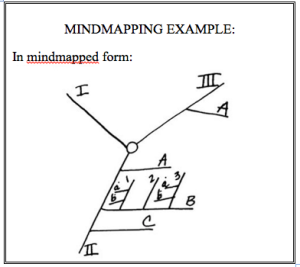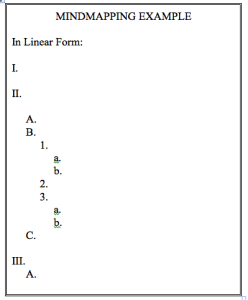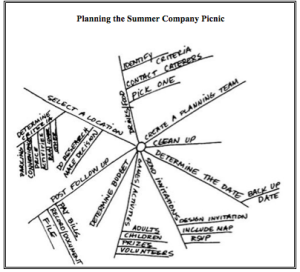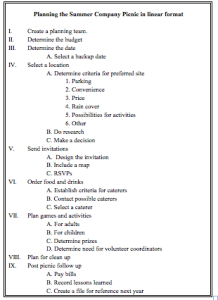“Sometimes we brainstorm information and ideas that need to be subsequently placed into a specific sequence, order, or outline. But our group likes to brainstorm in a nonsequential manner, much like the process outlined in the Old Fashioned Way. Is there an efficient way to brainstorm that will allow us to later sequence the information without extra work?”
#2 Mind Mapping
What Is Mind Mapping?
Mind Mapping is a brainstorming technique for quickly charting your group’s ideas in logical groupings, even when members give ideas in a nonsequential manner.
It is impossible to effectively outline ideas in a traditional, linear format while brainstorming. The Mind Mapping technique allows you to efficiently brainstorm for ideas as well as simultaneously create a skeletal framework for later categorization of the information you collect.
Examples of situations that benefit from Mind Mapping include planning agendas or projects, identifying customer groups, or dealing with any process that contains many components.
When to Use Mind Mapping
- When group members will have to remember many steps or issues
- When you are brainstorming information to be outlined or sequenced instead of brainstorming specific solutions to a problem
NOTE: Mind Mapping works best when topics have many components and subcomponents or when there are a number of different categories of information. Mind Mapping does not work well when the participants are brainstorming ideas that they will later narrow down to the best one or two ideas.
How to Use Mind Mapping
Before the Meeting
1. Identify specifically what you want to brainstorm. Plan an open-ended question to focus the brainstorming. You might say, for example: “What are the steps in completing this project?” “Which types of customers shall we target for testing our new product?” “What still needs to be done in order to finalize the annual report?” or “What do we need to do to be prepared for the move to the new building next month?”
NOTE: The first time you use Mind Mapping with your meeting group, you will want to create two instructional charts. The below charts illustrate how the Mind Mapping process works and how it later translates into a linear format.
During the Meeting
1. Introduce the topic, the question, and the Mind Mapping technique. For example: “As you know, our group is moving to the new building next year. I’d like your help in planning for that move. Let’s start by mind mapping your answers to the question, ‘What do we need to do to be prepared for the move to the new building next year?’”
NOTE: If your group has never used Mind Mapping before, take a few moments at this point to explain the process. You might say, for example, “We’ve never used the brainstorming technique called Mind Mapping before. Basically, it is a nonlinear way of outlining brainstormed information. This is an example of how it might look when it is finished”
“The main arms or branches that emanate from the circle at the center represent the primary ideas or categories that have been brainstormed. The secondary branches represent the subissues of the primary categories, and the smaller branches are the subsets of the secondary categories, and so on. The idea is similar in structure to the old outline form that many of us learned in school, with roman numerals, letters, and numbers.
2. Begin the brainstorming session, writing all your group’s ideas down on the appropriate section of the Mind Map. Brainstorm to an appropriate level of detail given your purpose. Continue to brainstorm until the group has exhausted all pertinent information or ideas.
OPTION: If your Mind Map is getting too complex and cumbersome, consider taking an arm of the Mind Map and using it to create a new, separate, more specific Mind Map.
Below is an example of a completed Mind Map, one that categorizes the information brainstormed for planning the summer company picnic.
4. After completing your mind map, have the group sequence the information if appropriate. You might say, for example, “Which of these arms or branches needs to be dealt with first?” “Which is next important?” and so on. Number them as the group dictates and reproduce your outline in linear form if appropriate. Below is the resulting linearly formatted outline created from the Mind Map of the company picnic.
NOTE: You may find you want to move some information to different sections once your Mind Map is developed.
Summary
Mind Mapping is a nonlinear way of outlining ideas. It works best when the group is not likely to eliminate information but will need to categorize, sequence, or prioritize the information.
Before the Meeting
Identify specifically what you want to brainstorm. Plan an open-ended question to focus the brainstorming discussion.
During the Meeting
- Introduce the topic, the question, and the Mind Mapping technique.
- Prepare your Mind Mapping chart by drawing a circle in the middle of a clean sheet of chart paper. Write your topic or question in the circle or at the top of the chart.
- Begin brainstorming, writing all ideas down on the Mind Map. Brainstorm to an appropriate level of detail.
- After completing your Mind Map, have the group sequence the information if ap- propriate. Prioritize the items as the group dictates and reproduce your outline in linear form if necessary.
Source
Buzan, Tony. 1993. The Mind Map Book. New York: Dutton.
———————-
NOTE: If you would like to receive e-mail notification when I post additional techniques, please sign up through this link. http://eepurl.com/KILan You may unsubscribe at any time.




4 Responses to Six Techniques to Brainstorm Ideas: #2 Mind Mapping